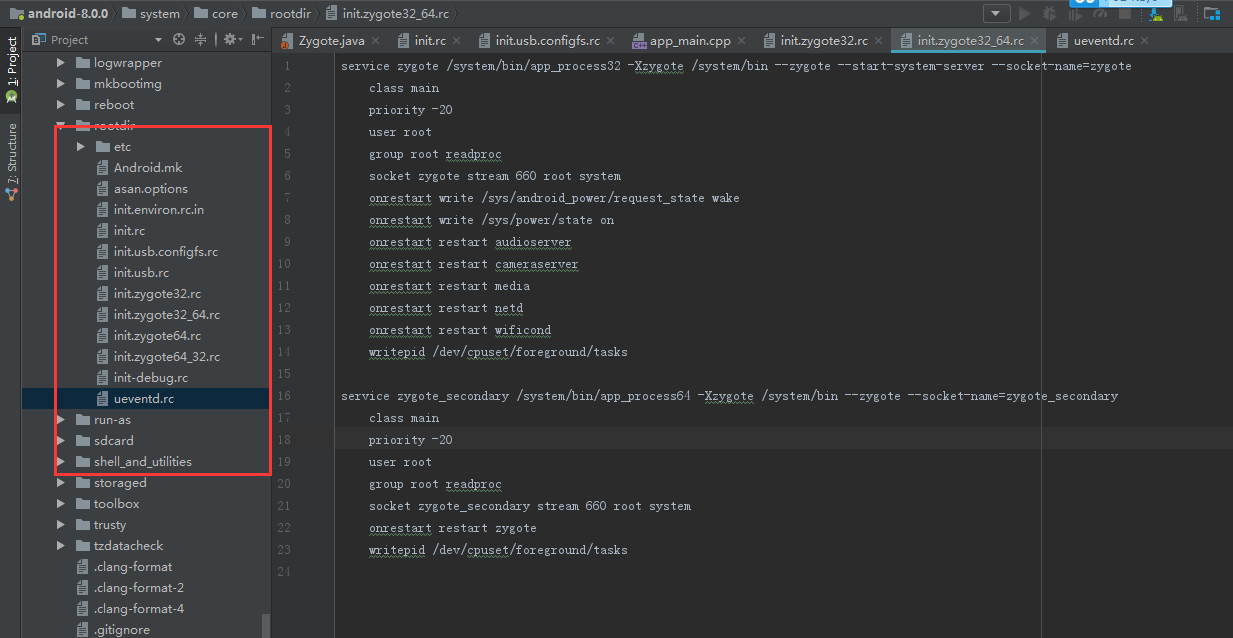上一节我们详细的看了下Android应用进程的启动过程分析,知道了应用进程是由Zygote进程调用Linux的系统函数fork复制出来的,那么Zygote进程是怎么启动起来的?这节我们就来看一下Zygote进程的启动过程。
当我们的Android手机开机时,Linux的init进程会去加载init.rc配置文件,老罗博客上讲的是Android 2.3的系统,当前应该还没有64位的虚拟机,所以Zygote进程的启动都是配置在init.rc文件中,而8.0的Android源码中已经支持了32位的虚拟机和64位的虚拟机,而且有主次之分,所以就会有四个配置文件,截图如下:
该配置文件的目录路径为:system\core\rootdir\,init.zygote32.rc文件表示当前的手机只配置有32位的Zygote,init.zygote32_64.rc文件表示当前的Zygote同时配置有32位和64位,而且以32位为主Zygote,64位为次Zygote,主次是怎么区分的呢?就是从配置文件中的--socket-name属性来区分的。另外两个init.zygote64.rc、init.zygote64_32.rc分别表示只支持64位的Zygote和同时两个支持,但是以64位为主。init.zygote32_64.rc配置文件的源码如下:
service zygote /system/bin/app_process32 -Xzygote /system/bin --zygote --start-system-server --socket-name=zygote
class main
priority -20
user root
group root readproc
socket zygote stream 660 root system
onrestart write /sys/android_power/request_state wake
onrestart write /sys/power/state on
onrestart restart audioserver
onrestart restart cameraserver
onrestart restart media
onrestart restart netd
onrestart restart wificond
writepid /dev/cpuset/foreground/tasks
service zygote_secondary /system/bin/app_process64 -Xzygote /system/bin --zygote --socket-name=zygote_secondary
class main
priority -20
user root
group root readproc
socket zygote_secondary stream 660 root system
onrestart restart zygote
writepid /dev/cpuset/foreground/tasks
大家可以看到,两个Zygote的name属性就表示出它们的主次了。init.rc文件加载完成后,两个Zygote虚拟机的name属性也用来在AMS请求创建新的应用进程时,进行匹配,这个过程我们上节已经看到了。Zygote是以service配置的,所以当解析该完成时,init进程就会调用fork去创建Zygote进程,并且执行app_main.cpp文件中的main函数,作为Zygote进行的启动入口。app_main.cpp文件的目录路径为:frameworks\base\cmds\app_process\app_main.cpp,它的main函数的源码如下:
int main(int argc, char* const argv[])
{
if (!LOG_NDEBUG) {
String8 argv_String;
for (int i = 0; i < argc; ++i) {
argv_String.append("\"");
argv_String.append(argv[i]);
argv_String.append("\" ");
}
ALOGV("app_process main with argv: %s", argv_String.string());
}
AppRuntime runtime(argv[0], computeArgBlockSize(argc, argv));
// Process command line arguments
// ignore argv[0]
argc--;
argv++;
// Everything up to '--' or first non '-' arg goes to the vm.
//
// The first argument after the VM args is the "parent dir", which
// is currently unused.
//
// After the parent dir, we expect one or more the following internal
// arguments :
//
// --zygote : Start in zygote mode
// --start-system-server : Start the system server.
// --application : Start in application (stand alone, non zygote) mode.
// --nice-name : The nice name for this process.
//
// For non zygote starts, these arguments will be followed by
// the main class name. All remaining arguments are passed to
// the main method of this class.
//
// For zygote starts, all remaining arguments are passed to the zygote.
// main function.
//
// Note that we must copy argument string values since we will rewrite the
// entire argument block when we apply the nice name to argv0.
//
// As an exception to the above rule, anything in "spaced commands"
// goes to the vm even though it has a space in it.
const char* spaced_commands[] = { "-cp", "-classpath" };
// Allow "spaced commands" to be succeeded by exactly 1 argument (regardless of -s).
bool known_command = false;
int i;
for (i = 0; i < argc; i++) {
if (known_command == true) {
runtime.addOption(strdup(argv[i]));
ALOGV("app_process main add known option '%s'", argv[i]);
known_command = false;
continue;
}
for (int j = 0;
j < static_cast<int>(sizeof(spaced_commands) / sizeof(spaced_commands[0]));
++j) {
if (strcmp(argv[i], spaced_commands[j]) == 0) {
known_command = true;
ALOGV("app_process main found known command '%s'", argv[i]);
}
}
if (argv[i][0] != '-') {
break;
}
if (argv[i][1] == '-' && argv[i][2] == 0) {
++i; // Skip --.
break;
}
runtime.addOption(strdup(argv[i]));
ALOGV("app_process main add option '%s'", argv[i]);
}
// Parse runtime arguments. Stop at first unrecognized option.
bool zygote = false;
bool startSystemServer = false;
bool application = false;
String8 niceName;
String8 className;
++i; // Skip unused "parent dir" argument.
while (i < argc) {
const char* arg = argv[i++];
if (strcmp(arg, "--zygote") == 0) {
zygote = true;
niceName = ZYGOTE_NICE_NAME;
} else if (strcmp(arg, "--start-system-server") == 0) {
startSystemServer = true;
} else if (strcmp(arg, "--application") == 0) {
application = true;
} else if (strncmp(arg, "--nice-name=", 12) == 0) {
niceName.setTo(arg + 12);
} else if (strncmp(arg, "--", 2) != 0) {
className.setTo(arg);
break;
} else {
--i;
break;
}
}
Vector<String8> args;
if (!className.isEmpty()) {
// We're not in zygote mode, the only argument we need to pass
// to RuntimeInit is the application argument.
//
// The Remainder of args get passed to startup class main(). Make
// copies of them before we overwrite them with the process name.
args.add(application ? String8("application") : String8("tool"));
runtime.setClassNameAndArgs(className, argc - i, argv + i);
if (!LOG_NDEBUG) {
String8 restOfArgs;
char* const* argv_new = argv + i;
int argc_new = argc - i;
for (int k = 0; k < argc_new; ++k) {
restOfArgs.append("\"");
restOfArgs.append(argv_new[k]);
restOfArgs.append("\" ");
}
ALOGV("Class name = %s, args = %s", className.string(), restOfArgs.string());
}
} else {
// We're in zygote mode.
maybeCreateDalvikCache();
if (startSystemServer) {
args.add(String8("start-system-server"));
}
char prop[PROP_VALUE_MAX];
if (property_get(ABI_LIST_PROPERTY, prop, NULL) == 0) {
LOG_ALWAYS_FATAL("app_process: Unable to determine ABI list from property %s.",
ABI_LIST_PROPERTY);
return 11;
}
String8 abiFlag("--abi-list=");
abiFlag.append(prop);
args.add(abiFlag);
// In zygote mode, pass all remaining arguments to the zygote
// main() method.
for (; i < argc; ++i) {
args.add(String8(argv[i]));
}
}
if (!niceName.isEmpty()) {
runtime.setArgv0(niceName.string(), true /* setProcName */);
}
if (zygote) {
runtime.start("com.android.internal.os.ZygoteInit", args, zygote);
} else if (className) {
runtime.start("com.android.internal.os.RuntimeInit", args, zygote);
} else {
fprintf(stderr, "Error: no class name or --zygote supplied.\n");
app_usage();
LOG_ALWAYS_FATAL("app_process: no class name or --zygote supplied.");
}
}该函数首先创建一个AppRuntime对象,然后对init.rc配置文件中的启动参数argc、argv[]进行解析,while循环中我们可以看到,如果配置的启动参数为--zygote,表示要启动Zygote进程,如果为--start-system-server表示要启动SystemServer进程,如果为--application就表示是普通的应用进程。我们当前的场景中就是第一个,参数解析完成后,此时的局部变量zygote的值为true,最后的if/else分支就会执行runtime.start("com.android.internal.os.ZygoteInit", args, zygote)来继续完成Zygote进行的启动。
接下来我们就看看AppRuntime的创建过程,AppRuntime类的定义也是在app_main文件中,该类的源码如下:
class AppRuntime : public AndroidRuntime
{
public:
AppRuntime(char* argBlockStart, const size_t argBlockLength)
: AndroidRuntime(argBlockStart, argBlockLength)
, mClass(NULL)
{
}
void setClassNameAndArgs(const String8& className, int argc, char * const *argv) {
mClassName = className;
for (int i = 0; i < argc; ++i) {
mArgs.add(String8(argv[i]));
}
}
virtual void onVmCreated(JNIEnv*







 本文分析了Android系统启动时Zygote进程的创建过程。从init.rc配置文件开始,探讨了在Android 8.0中如何支持32位和64位虚拟机,并详细阐述了Zygote启动时的配置文件、AppRuntime的创建以及JNI_CreateJavaVM方法在启动虚拟机中的作用。Zygote启动后,进入无限循环,等待Activity Manager Service请求创建新进程。
本文分析了Android系统启动时Zygote进程的创建过程。从init.rc配置文件开始,探讨了在Android 8.0中如何支持32位和64位虚拟机,并详细阐述了Zygote启动时的配置文件、AppRuntime的创建以及JNI_CreateJavaVM方法在启动虚拟机中的作用。Zygote启动后,进入无限循环,等待Activity Manager Service请求创建新进程。

 最低0.47元/天 解锁文章
最低0.47元/天 解锁文章


















 729
729

 被折叠的 条评论
为什么被折叠?
被折叠的 条评论
为什么被折叠?










